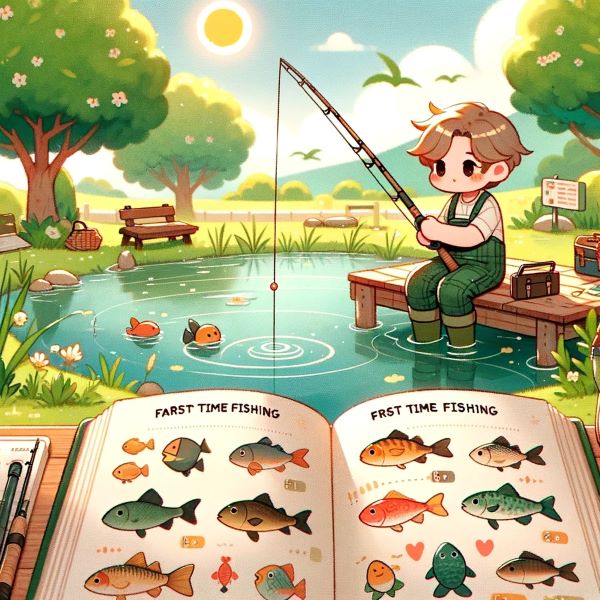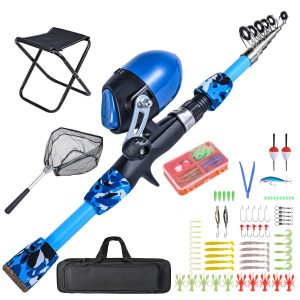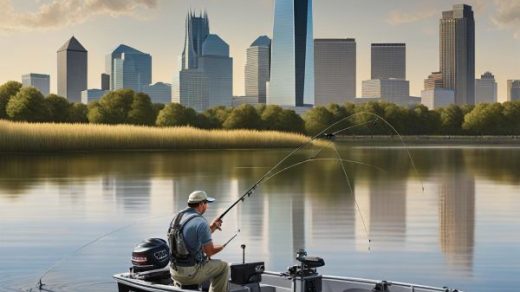Getting Started with Fishing
Understanding the Basics
At its core, fishing is about connecting with nature in a way that few other activities can match. It’s an opportunity to slow down, observe the rhythms of the water and wildlife, and learn about the delicate balance of aquatic ecosystems. But before you cast your line into the water, it’s important to grasp a few fundamental concepts:
- Patience and Persistence: Fishing is a test of patience. Some days, the fish bite within minutes; other times, hours can pass without a nibble. Embrace each outing as a chance to learn and enjoy the experience, regardless of the day’s catch.
- Continuous Learning: A fisherman’s journey is paved with continuous learning—from mastering different fishing techniques to understanding fish behavior and habitat. Every trip is an opportunity to gain new insights and improve your skills.
- Respect for Nature: Fishing comes with a responsibility to protect and preserve natural waterways and fish populations. Practicing catch and release, following local fishing regulations, and being mindful of the environment are all part of being a conscientious angler.
Legal Requirements and Conservation
Before you head out, it’s crucial to familiarize yourself with the legal aspects of fishing:
- Fishing License: Most states require anglers to have a fishing license. Licenses contribute to conservation efforts, such as habitat restoration and fish stocking programs, ensuring the health and sustainability of fish populations for future generations.
Check your state’s Department of Natural Resources (DNR) or equivalent agency for specifics. - Fishing Regulations: Regulations vary by state and sometimes by water body. They can include information on season openings, size and bag limits, and restricted areas.
Adhering to these rules is essential for the preservation of fish species and their habitats.
Being informed and prepared is the first step toward a successful and enjoyable fishing experience. By understanding the basics and committing to responsible fishing practices, you’re not just participating in a cherished pastime; you’re also contributing to the stewardship of our planet’s precious waterways and aquatic life.
As you gear up for your first fishing adventure, remember that each cast is a story in the making—a blend of anticipation, surprise, and sometimes, the catch of a lifetime. To learn more about the fishing regulations in your state please visit the National Park Service at https://www.nps.gov/subjects/fishing/index.htm
Essential Gear and Tackle for Beginners
The right gear and tackle.
This toolkit not only equips you for your first cast but also ensures you’re prepared for various fishing scenarios. Below, we’ll break down the essentials, from selecting the perfect rod and reel to understanding the purpose of each piece of tackle. With the right setup, you’ll be ready to tackle the waters and enjoy the fishing experience to its fullest.
Choosing the Right Fishing Rod and Reel
The heart of your fishing gear is the rod and reel combo. It’s essential to choose equipment that feels comfortable for you and is suitable for the type of fishing you’ll be doing.
- Closed Spin-Casting Reels: Ideal for beginners, these reels feature a button release mechanism for casting, making them very user-friendly. They’re mounted on top of the rod’s handle, offering a comfortable pistol-like grip. This setup is forgiving for newcomers and helps in learning the basics of casting.
- Open-Bail Spinning Reels: A step up in complexity, these reels offer more control and precision. Mounted under the rod’s handle, they require you to release the line with your index finger during the cast. Though slightly more challenging to master, an open-bail reel can be more versatile and rewarding as your skills progress.
When selecting a rod, ensure it’s light enough to hold comfortably for extended periods. Rods come in various lengths and flexibilities, each suited to different fishing styles and target species. A medium-action rod is a good all-rounder for beginners.
A note to you you do not have to go out and spend a lot of money on your first Rod And Reel you can pick one up for under $20 buck at your local Walmart or Pro Shop.
Examples:
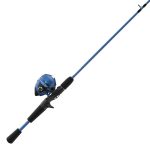 Amazon, Zebco Slingshot Spincast Reel and Fishing Rod $10.30
Amazon, Zebco Slingshot Spincast Reel and Fishing Rod $10.30
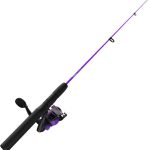 tackle direct, ZEBCO DOCK DEMON SPINNING COMBOS $15.99
tackle direct, ZEBCO DOCK DEMON SPINNING COMBOS $15.99
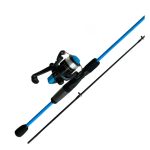 Walmart, Ozark Trail Wayfarer Spinning Fishing Rod and Reel Combo, Blue $9.98
Walmart, Ozark Trail Wayfarer Spinning Fishing Rod and Reel Combo, Blue $9.98
Line, Hooks, Weights, and Bobbers
After choosing your rod and reel, it’s time to focus on the tackle that will help you catch fish.
- Monofilament Fishing Line: This type of line is affordable, easy to use, and suitable for a range of conditions. For beginners, a 4- to 12-pound-test line is versatile enough for various freshwater fish.
- Fishhooks: The size of your hook should match the size of the fish you’re targeting. Sizes 6–10 are good for many freshwater species. Remember, the larger the number, the smaller the hook.
- Weights: Adding weights to your line helps sink your bait to the desired depth. They’re particularly useful in deeper water or when fishing in current.
- Bobbers: Also known as floaters, bobbers signal when a fish is biting by moving up and down. They also help keep your bait at the correct depth. A simple plastic or cork bobber is easy to use and effective.
Again You do not need to break the bank for your first time out pick up a starter set from WM Pro Shop or Amazone to get you started.
Quick links to starter sets
Bait and Lures
Your choice of bait or lures can significantly affect your success. While live bait is often more attractive to fish, artificial lures can be more convenient and reusable.
- Live Bait: Worms, minnows, and insects are common choices. Live bait is effective because it naturally attracts fish through movement and scent.
- Lures: These artificial baits are designed to mimic the appearance and motion of prey. For beginners, simple spinners or spoons can be easy to use and are effective for a variety of fish.
Miscellaneous Essentials
- Tackle Box: A good tackle box will keep your gear organized and easily accessible. Consider one with adjustable compartments to accommodate different-sized items.
- Net and Gloves: A net helps you land fish more easily and safely. Rubber gloves or a wet rag can protect both you and the fish during handling, especially important for catch and release.
Again here are some Cheap Options.
Blusea Kids Fishing Rod and Reel Combo Kit with Fishing Stool Landing Net Telescopic Fishing Pole Tackle Box
With this essential gear and tackle, you’re well on your way to a successful fishing adventure. Remember, the key is to start simple and gradually build your knowledge and equipment as you gain experience.
Each piece of gear plays a role in the art of fishing, and understanding how to use them effectively will enhance your enjoyment and success on the water.
Setting Up Your Fishing Rod
Properly setting up your fishing rod is crucial for a successful day on the water. This process, often seen as a rite of passage for many anglers, involves attaching your reel, threading your line, and securing your hook, weights, and bobber.
The setup can vary depending on the type of fishing you’re doing, but the basics outlined below will get you started and ready to cast in no time.
Attaching Your Reel to the Rod
The first step in setting up your fishing rod is to securely attach the reel. This process is straightforward but essential for a smooth fishing experience:
- Open the reel seat: This is usually done by twisting the components at the bottom of the rod to loosen them.
- Insert the reel foot: Slide the foot of the reel into the reel seat. The reel should sit comfortably and be aligned with the guides of the rod.
- Secure the reel: Tighten the reel seat around the foot of the reel until it is snug and does not wobble or rotate.
Threading the Line Through the Guide
Once your reel is attached, you’ll need to thread the fishing line through the guides of the rod:
- Open the bail: If you’re using an open-bail spinning reel, make sure the bail is open to allow the line to freely pass through.
- Thread the line: Start at the guide closest to the reel and thread the line through each guide towards the tip of the rod. Be careful not to miss any guides, as this can affect your casting and reeling.
- Close the bail manually: Once the line is threaded, manually close the bail to secure the line in place.
Tying on a Hook and Attaching Tackle
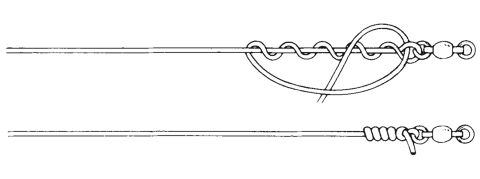
The final steps involve tying on your hook and attaching any additional tackle like weights and bobbers:
- Tying a Hook: One of the most effective and popular knots for beginners is the Improved Clinch Knot. Here’s how to tie it:
- Pass the line through the eye of the hook, leaving enough tail for wrapping.
- Wrap the tail around the standing line 5 to 7 times.
- Thread the tail through the small loop near the hook eye, then back through the loop you’ve just created.
- Moisten the line (with water or saliva) to reduce friction.
- Pull both ends of the line to tighten the knot securely against the eye of the hook.
- Attaching Weights and Bobbers:
- Weights: Clip on your weights 6 to 12 inches above the hook. This placement helps your bait sink to the desired depth and keeps it there.
- Bobbers: Attach your bobber to the line above the weights. The distance between the bobber and the hook will depend on the depth of the water you’re fishing in.
Most bobbers have a simple clip mechanism that makes adjustment easy.
Final Checks and Adjustments
Before you cast your line, do a final check to ensure everything is secure and correctly set up.
Make sure the line is not twisted around the rod, the knot is tight and trimmed close to the hook, and the tackle is appropriately placed for the depth you’re aiming to fish.
Setting up your fishing rod correctly is a fundamental skill that all anglers should master. With practice, these steps will become second nature, allowing you to focus more on the fishing experience itself.
Learning to Cast: The First Step to Catching Fish
Mastering the art of casting is a pivotal skill for any angler. A well-executed cast places your bait or lure exactly where you want it, increasing your chances of a bite.
Whether you’re using a closed spin-casting reel or an open-bail spinning reel, the key lies in practice and understanding the mechanics of each method.
Let’s dive into the basics of casting with both types of reels, setting you on the path to becoming a proficient angler.
Casting with a Closed Spin-Casting Reel
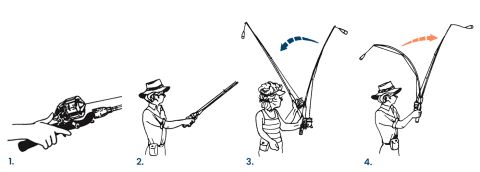
Closed spin-casting reels are beginner-friendly, offering a simple push-button mechanism to release the line.
Here’s how to cast with one:
- Hold the Rod: Grip the rod’s handle with the reel seated above, using your dominant hand. Your thumb should rest comfortably on the reel’s button.
- Prepare to Cast: Point the rod tip towards your target, keeping the rod at about a 45-degree angle to the ground.
Ensure the line roller (guide closest to the reel) is directly beneath the rod, facing your target.
Press and Hold the Button: Press down on the button with your thumb to disengage the line lock. Keep it held down as you prepare to cast. - The Casting Motion: In one smooth motion, swing the rod tip upwards and over your shoulder, then swiftly forward towards your target.
Aim to have the rod tip slightly above eye level at the end of your forward motion. - Release the Button: As the rod comes forward and reaches eye level, release the button to send the line flying towards your target.
The timing of your thumb release is crucial—the later you release, the higher and shorter your cast; the earlier you release, the longer and lower your cast.
Casting with an Open-Bail Spinning Reel
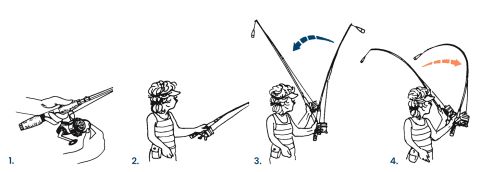
Open-bail spinning reels offer more control and are preferred by many experienced anglers. Casting with these reels involves a bit more technique:
- Hold the Rod: Grip the rod’s handle so that the reel is underneath, with the stem of the reel between your middle fingers.
Place your thumb on top of the handle and your index finger over the line on the reel spool. - Open the Bail: Use your other hand to flip the bail arm over to open it. This action frees the line for casting.
- Prepare the Line: With the bail open, use your index finger to pull the line slightly away from the reel and hold it against the rod’s grip. This provides tension and control for the cast.
- The Casting Motion: Like with the spin-casting reel, bring the rod tip up and over your shoulder, then forward in a smooth arc towards your target.
The motion should be fluid, using your wrist and forearm.
Release the Line: As the rod comes forward and reaches the optimal angle (about eye level), release the line from your index finger. Timing is everything—the moment of release dictates the direction and distance of your cast.
Practice Makes Perfect
Casting is a skill that improves with practice. Start in an open area, free from overhead obstructions like trees and power lines.
Practice casting with a rubber weight or a practice plug instead of hooks to avoid accidents.
Troubleshooting Common Mistakes
- If the lure lands too close: You’re releasing the line (or button) too late. Try releasing it earlier in your casting motion.
- If the lure goes too high or too short: You’re likely releasing too soon. Hold on a bit longer for a more direct cast.
Casting is the first active step in the fishing process, setting the stage for everything that follows. By mastering the basics of casting, you lay the foundation for countless memorable fishing adventures.
Remember, patience and persistence are your allies here—every cast is a learning opportunity, bringing you closer to the angler you aspire to be.
Catch and Release: A Conservation Ethic
Catch and release is a practice deeply rooted in the fishing community, emphasizing the importance of conserving fish populations for future generations while still enjoying the sport of angling.
This conservation ethic not only ensures the sustainability of fisheries but also respects the lives of the fish we seek to catch.
Here’s how to responsibly practice catch and release, ensuring that fish have the best chance of survival after being caught.
The Importance of Responsible Fishing
Fishing responsibly means being mindful of the impact we have on aquatic ecosystems. By practicing catch and release, anglers contribute to maintaining healthy fish populations and ecosystems, allowing others to enjoy the sport while ensuring environmental stewardship. It’s a balance between enjoying the thrill of the catch and preserving natural resources.
Tips for Safely Releasing Fish
To maximize the chances of a fish’s survival after release, consider the following guidelines:
- Handle With Care: Fish have a protective slime coating that is vital to their health, as it protects against infections and helps with swimming.
When handling fish, wet your hands or wear wet gloves to minimize damage to this slime coat. Avoid touching the gills or squeezing the fish tightly.
- Use the Right Gear: Barbless hooks or circle hooks are less harmful to fish, making them easier to remove and reducing injury. Using a net can also minimize stress and physical damage to the fish.
Opt for rubberized nets instead of nylon or knotted nets, as they are gentler on the fish’s skin and scales. - Quick Hook Removal: Remove the hook as quickly and gently as possible. If the fish has swallowed the hook, it’s often better to cut the line as close to the mouth as possible rather than trying to remove the hook forcefully.
- Minimize Air Exposure: Keep the fish in the water as much as possible. If you need to take a photo, prepare your camera beforehand and lift the fish out of the water for just a few seconds. Extended exposure to air can be harmful to fish.
- Revive the Fish if Necessary: Before releasing the fish, hold it gently in the water, moving it back and forth to encourage water flow through its gills.
This process helps to oxygenate the fish and revive it if it’s exhausted from the fight. Release the fish once it starts swimming actively on its own. - Choose the Right Time and Place: Avoid catch and release in extreme conditions, such as very hot weather, which can increase stress and mortality rates in fish.
Also, release the fish back into the same habitat from which it was caught to ensure it’s in a familiar environment.
The Ethical Angler
Being an ethical angler means respecting the environment, following local regulations, and practicing catch and release correctly.
It’s about fostering a conservation mindset that values the health and sustainability of fish populations and their habitats.
Catch and release, when done properly, allows anglers to enjoy the sport of fishing while minimizing their ecological footprint. It’s a practice that underscores the importance of conservation, respect for nature, and the role of anglers as stewards of the environment.
By adopting these practices, you contribute to the preservation of fisheries for future generations, ensuring that the joys of fishing can be experienced by all who follow.
Additional Tips for Successful Fishing
Fishing is an art that combines skill, patience, and a bit of luck. Beyond the basics of gear selection, casting, and catch and release, there are additional nuances that can enhance your fishing experience and increase your success rate. Here are some supplementary tips that seasoned anglers swear by, designed to refine your approach and deepen your connection with the sport.
Local Knowledge is Key
- Talk to Local Anglers: No one knows the waters better than local fishermen. They can offer invaluable insights into what fish are biting on, the best times to fish, and hidden spots that are less pressured.
- Visit Local Tackle Shops: These are hubs of local fishing information. Staff and patrons alike usually enjoy sharing tips, recommending baits, and discussing recent catches. Plus, supporting local businesses helps sustain the fishing community.
Understand Your Quarry
- Research Fish Behavior: Different species have unique habits and preferences. Understanding the feeding patterns, preferred habitats, and seasonal movements of your target species can significantly improve your chances.
- Adapt to Conditions: Fish behavior changes with weather conditions, water temperature, and time of day. Learn how these factors affect fish activity and adjust your techniques accordingly.
Master a Variety of Techniques
- Versatility: Don’t rely on a single fishing method. Be open to trying different techniques, whether it’s fly fishing, lure casting, or bottom fishing. Each method has its time and place, and versatility will make you a more successful angler.
- Continuous Learning: The fishing world is always evolving, with new tactics and gear introduced regularly. Stay curious and open to learning, whether through reading, watching tutorials, or attending workshops.
Gear Maintenance
- Regular Checks: Periodically inspect your gear for wear and tear. Ensure your reels are clean and lubricated, your lines are free from nicks and kinks, and your hooks are sharp.
- Invest in Quality: While you don’t need the most expensive gear, investing in quality equipment that can withstand the rigors of fishing pays off in the long run.
Patience and Observation
- Be Patient: Fishing is as much about patience as it is about action. Sometimes, the key to success is simply spending more time on the water, observing, and waiting for the right moment.
- Observe Nature: Pay attention to the natural cues around you. Birds diving into the water can indicate baitfish activity, which in turn suggests the presence of larger predators.
Practice Conservation
- Leave No Trace: Always clean up after yourself. Leaving behind litter, especially fishing line and plastic, can harm wildlife and degrade the natural beauty of fishing spots.
- Promote Sustainable Practices: Encourage others to fish responsibly. Share your knowledge of catch and release, gear maintenance, and conservation with fellow anglers, especially newcomers.
Enjoy the Experience
- Fishing is More Than Catching Fish: Remember, the essence of fishing lies in the experience itself—the serenity of nature, the thrill of the bite, and the joy of spending time outdoors.
Success isn’t just measured by the size or quantity of your catch but by the memories created and the lessons learned along the way.
As you stand on the threshold of the vast and rewarding world of fishing, you’re equipped not just with the gear, but with the knowledge and respect that form the cornerstone of a true angler’s ethos.
From selecting the right equipment and mastering the art of casting to practicing catch and release with a conservation mindset, every step you take enriches your journey and deepens your connection with the natural world.
Fishing is more than a hobby—it’s a passage into a community that values patience, skill, and stewardship of our waterways. It invites you to continually learn, adapt, and grow, not only as an angler but as a guardian of the environment.
Remember, the journey of fishing is one of constant discovery, where every outing offers lessons not just about fishing, but about life.
Encouragement to Respect Nature, Continue Learning and Enjoy the Process
Respect for nature, a commitment to learning, and an appreciation for the moment are what make fishing an enduring and fulfilling pursuit.
Whether you’re casting a line into a tranquil lake at dawn or watching the sunset over a whispering river, fishing offers a profound way to connect with the world around you.
Frequently Asked Questions
- Q1: How do I know if I need a fishing license?
- A: Fishing licenses are required in most regions to fish legally. The requirements can vary based on your location, age, and the type of fishing. Always check with your local fish and wildlife agency or department of natural resources for the most accurate information.
- Q2: What’s the best time of day for freshwater fishing?
- A: Early morning and late afternoon into evening are generally the best times for freshwater fishing. These periods coincide with times when fish are most actively feeding. However, fish behavior can vary by species and season, so observing local conditions and habits is beneficial.
- Q3: How do I choose between live bait and lures?
- A: The choice between live bait and lures depends on several factors, including the target species, fishing conditions, and personal preference. Live bait is often more effective for beginners, as it naturally attracts fish.
Lures require more skill but offer the advantage of targeting specific species and conditions. Experimenting with both can help you determine what works best for you.
- A: The choice between live bait and lures depends on several factors, including the target species, fishing conditions, and personal preference. Live bait is often more effective for beginners, as it naturally attracts fish.
- Q4: What should I do if I’m not catching any fish?
- A: Not catching fish is a common part of the learning process in fishing. Consider it an opportunity to experiment and learn. Try changing locations, adjusting your bait or lure, varying your casting technique, or switching the time of day you’re fishing. Sometimes, patience and subtle changes are all it takes to turn your luck around.
The journey of fishing is a lifelong adventure, filled with opportunities to learn, grow, and connect with the natural world. Each cast is a fresh start, a chance to experience the thrill of the strike.
Every day on the water is a gift, a chance to soak in the peace and tranquility that only nature can provide. Welcome to the world of fishing – may your lines stay taut, your catches be plentiful, and your heart brim with the joy of every moment spent by the water’s edge.
